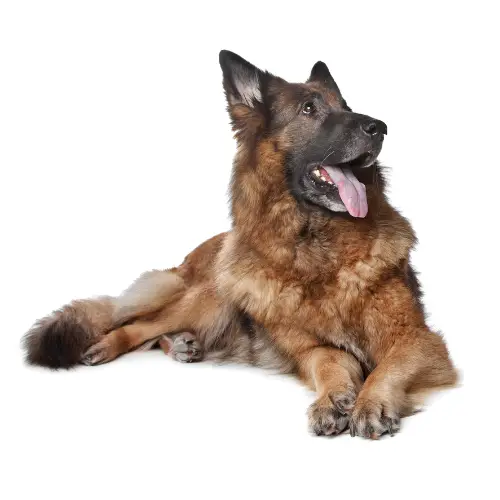German Shepherds are one of the most popular dog breeds out there, and if you’re lucky enough to own one, you probably know how amazing these dogs can be. However, determining a German Shepherd’s age can be a bit tricky, especially if you adopted your furry friend from a shelter or rescue. In this article, we’ll take a deep dive into the different ways to tell how old your German Shepherd is.
Check the dog’s teeth
To determine the approximate age of a German Shepherd, you can examine the dog’s teeth. Here are some general guidelines:
- Puppy Teeth (0-6 months): At birth, German Shepherd puppies have no teeth. Around 3-4 weeks, they begin to develop baby teeth, which are sharp and pointed. By 6-8 weeks, all 28 baby teeth should be present.
- Adult Teeth (6-8 months): At around 6-8 months, the baby teeth start to fall out, and the adult teeth start to come in. The adult teeth are larger and more robust than the baby teeth.
- Fully Developed Teeth (1-2 years): By 1-2 years, the German Shepherd should have all 42 teeth, and their teeth should be fully developed. The teeth should be clean and white, with minimal wear and tear.
Keep in mind that dental development can vary from dog to dog, and this method may not provide an accurate age assessment for all dogs. In some cases, a veterinarian may be able to provide a more accurate estimate based on other factors, such as the dog’s physical condition and overall health.
Look at the eyes
While it’s not possible to accurately determine the exact age of a German Shepherd just by looking at its eyes, there are some signs you can look for that may give you an estimate.
Here are some general guidelines to help you determine the age of a German Shepherd:
- Puppy: Up to 1 year old. Puppies have bright, clear eyes and their pupils may appear larger in relation to the size of their eyes. They also have baby teeth and soft, fluffy fur.
- Adolescent: 1-2 years old. Adolescents will start to lose their baby teeth and their adult teeth will start to grow in. Their eyes will start to become more focused and their bodies will become more muscular.
- Adult: 3-6 years old. Adults will have fully grown teeth and their eyes will be clear and bright, with the pupils proportionate to the size of their eyes. They will be at their peak physical condition during this age range.
- Senior: 7 years old and up. Seniors will start to show signs of aging, such as cloudy eyes, gray hair, and a slower gait. They may also have dental problems or other health issues associated with aging.
Check the coat
While it is difficult to determine the exact age of a German Shepherd just by looking at its coat, there are a few clues that can give you an idea of its age:
- Puppy Coat: German Shepherd puppies have a soft and fluffy coat that usually lasts until they are around six months old. If the dog still has a puppy coat, it is likely under six months of age.
- Adult Coat: German Shepherds typically develop their adult coat around six to eight months of age. An adult coat is usually thicker, coarser, and has a more distinct color pattern than a puppy coat.
- Graying: As dogs age, their fur may start to gray. If you notice gray hairs around the muzzle or on other parts of the dog’s body, it is likely that the dog is middle-aged or older.
- Wear and Tear: Older dogs may have more wear and tear on their coats, especially if they have spent a lot of time outdoors. Look for signs of fading, matting, or thinning of the coat.
Physical Activity
A dog’s physical activity level can be another indication of their age. Younger dogs are more energetic and enjoy playing and running around. They will have lots of energy to burn, and it can often be tough to keep up with them. As your German Shepherd ages, they may experience a decrease in energy and not be as eager to go on long walks or play as much as they used to.
Behaviour and temperament
Age can also impact a dog’s temperament and behaviour. Older dogs tend to be calmer and more relaxed, whereas younger dogs can be more excitable and rambunctious. An older German Shepherd may not be as interested in meeting new people or playing fetch. They might be more content to spend their time sleeping and relaxing.
However, keep in mind that every dog has their personality, and not all dogs are the same. Some older German Shepherds may still be very active and playful, while some younger dogs can be more laid back and relaxed.
Consult with a vet
Lastly, if you still can’t determine your German Shepherd’s age based on these methods, it’s best to consult with a veterinarian. A qualified vet can use their expertise to determine your dog’s age by taking into account their physical characteristics, including weight, muscle mass, and overall health.
Conclusion
In summary, there are several methods you can use to tell how old your German Shepherd is, including looking at their teeth, examining their eyes, checking their coat, observing their physical activity, examining their temperament and behaviour, and consulting with a veterinarian.
Remember, regardless of your dog’s age, love and proper care are essential to keeping them happy and healthy throughout their life.







